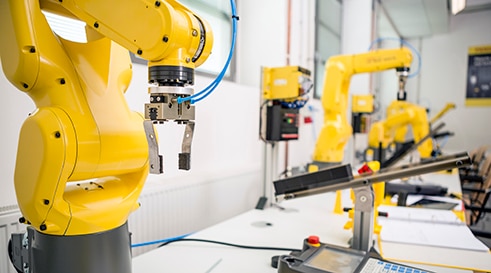
The use of collaborative robots, or co-bots, in the manufacturing industry is growing. In fact, estimates suggest that investments in co-bots could grow to $3 billion by 2020, according to market analysts at Barclays. A variety of factors are driving this adoption, one of which is a persistent industry-wide talent shortage and skills gap. And while the industry can invest more to attract and retain talent, co-bots may offer a more immediate solution.
Working better, together
Co-bots work alongside human workers, helping increase productivity and safety. For example, by performing tasks that pose ergonomic or other safety risks to workers, co-bots reduce the risk of employee injuries, free employees for more advanced-level thinking tasks such as quality control or co-bot programming, and also help increase the efficiency of each worker.
Co-bots boost worker efficiency and can reduce the total number of employees needed on the floor.
—Stacie Graham, Senior Vice President and General Manager, Central Division, Liberty Mutual Insurance
Managing the risks of co-bots
As beneficial as co-bots can be, they can also present risks. Here are five key areas that manufacturers should address before implementing co-bots in their factory operations:
- Safety
Using co-bots correctly can reduce the risk of employee injuries and workers compensation exposure, but misuse could place employees in harm’s way. Before introducing co-bots, a company should become familiar with industry requirements for the integration and safe use of co-bots. Employers should also conduct risks assessments and properly train employees — including maintenance crews and managers — on how to safely operate and work side-by-side with co-bots. - Product liability
If programmed incorrectly or if there is a malfunction, co-bots could produce faulty work that increases a company’s product liability exposure. Manufacturers should update quality control protocols to account for co-bots and also work with their insurance brokers and carriers to review and update coverage if needed.
- Contract language
Should machinery fail and cause a defect or injury, who is responsible — the co-bot manufacturer, the programmer, or the manufacturing facility? If a co-bot breaks due to a defect, who will foot the bill for repair or replacement? Manufacturers should consult with legal counsel to put contracts in place that assign liability appropriately.
- Contingency planning
What happens if the factory loses power? How quickly can the facility locate parts and complete repairs or install a replacement co-bot in the event of equipment breakdown? Manufacturers should have contingency plans that identify backup suppliers and service providers to minimize business interruptions and maintain service levels.
- Insurance coverage
When considering the use of co-bots, a manufacturer should review its insurance program to ensure it has the appropriate limits on coverages, such as property, equipment breakdown, business interruption, and operational replacement costs, to account for changes in scale and business processes.
By working alongside employees, co-bots can help bridge talent shortfalls and improve productivity in the manufacturing industry. Manufacturers that work closely with insurance partners to understand how co-bots may affect operations will be better equipped to incorporate them successfully and mitigate potential risks.
Related insights
This website is general in nature, and is provided as a courtesy to you. Information is accurate to the best of Liberty Mutual’s knowledge, but companies and individuals should not rely on it to prevent and mitigate all risks as an explanation of coverage or benefits under an insurance policy. Consult your professional advisor regarding your particular facts and circumstance. By citing external authorities or linking to other websites, Liberty Mutual is not endorsing them.



